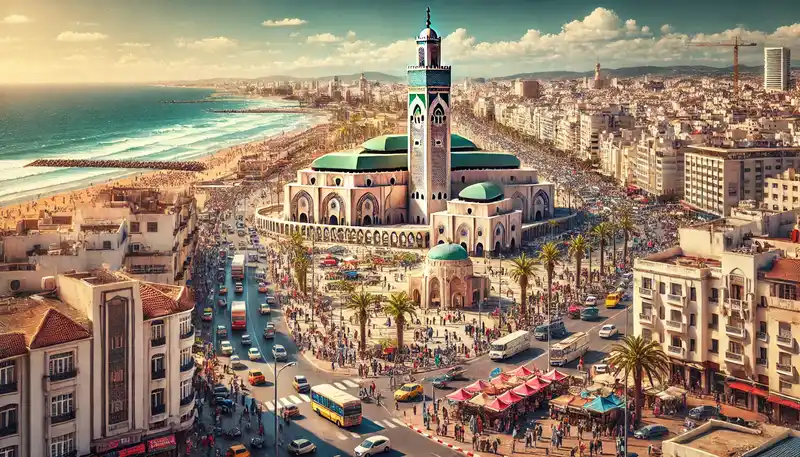Traveling to Casablanca: Accessibility, Essentials & Tips for First-Timers
Discover a traveler's firsthand experience navigating Casablanca, with tips on accessibility, internet options, dining, and local insights. Perfect for first-time visitors exploring Morocco’s vibrant city.

Casablanca, Morocco’s bustling economic hub, offers a mix of modernity and tradition, attracting visitors with its iconic landmarks, vibrant neighborhoods, and rich culture. This guide provides insights for first-time travelers on accessibility, internet setup, dining, and more, based on the experience of a family with diverse needs, including elderly parents and medical considerations.
Arriving in Casablanca: Navigating Customs and Essentials
Upon arrival, travelers should be prepared to go through customs individually, as family groups aren’t processed together. Once through, it’s helpful to exchange some money for Moroccan Dirhams (MAD) at the airport. Although tipping in USD may seem convenient, locals prefer MAD for easier currency exchange. Casablanca is also a straightforward city to navigate from the airport by train, with Casa Port station being a popular drop-off point for those headed to the city center.
Staying Connected: Internet and SIM Options
For internet access, Morocco offers several options, but e-SIM reliability can vary. Providers like Airlo offer strong coverage, while other options may struggle to connect. Travelers can also purchase local SIM cards from Maroc Telecom or Inwi stores at Casa Port or major locations. These local SIMs generally offer excellent 4G coverage and are a cost-effective way to stay connected. Some travelers also use pocket WiFi, but results can be mixed. For groups, local SIMs are often the most reliable choice.
Accommodations: Balancing Location and Accessibility
Casablanca offers a variety of accommodations that suit different budgets and needs. From high-end hotels to budget stays, location is a key factor, as some neighborhoods have more cleanliness and safety than others. Hotels around the Old Medina offer a cultural experience, though they may feel a bit less accessible and can be challenging for travelers with mobility issues.
For those with accessibility concerns, note that Casablanca’s sidewalks can be uneven, narrow, or abruptly end in some areas, which makes exploring on foot more difficult. Older travelers may want to plan accordingly, prioritizing stays near central attractions or landmarks with accessible paths, like the Hassan II Mosque.
Exploring Casablanca’s Highlights
One of Casablanca’s must-see attractions is the Hassan II Mosque. Perched by the sea, this mosque is renowned for its intricate design, stunning views, and informative guided tours. The mosque is accessible to most travelers and offers designated pathways for a smooth visitor experience.
Other popular spots include the Arab League Park, Quartier Habous, and the city’s old medina. The medina offers a look into Moroccan daily life but can be challenging to navigate due to its narrow pathways and busy markets. A stroll through the Mohammed V Square and the Corniche area by the coast provides a refreshing look at Casablanca’s urban and coastal charms.
Dining and Local Culture
Casablanca’s culinary scene provides a flavorful taste of Morocco, from street food to high-end dining. Freshly squeezed orange juice is a local favorite and often a highlight for travelers. Restaurants like La Sqala serve Moroccan dishes in a lively setting, with live music and a cozy ambiance. Traditional dishes like milk pastilla are worth trying for a memorable dining experience.
If you have a sensitive stomach, exercise caution with street food or ice in drinks until you’ve adjusted. Many visitors prefer eating at reputable restaurants initially before branching out to street vendors.
Medical Needs and Accessibility Considerations
If you or someone you’re traveling with has medical needs, bring essentials, especially items requiring refrigeration. Casablanca’s hotels and some camps offer small refrigerators, but it’s wise to carry cooling packs. Public restrooms can be scarce, especially in the medina, so planning ahead is essential. Pharmacies are generally accommodating, sometimes allowing travelers to use their private restrooms.
For those who may need mobility assistance, it’s important to know that accessibility varies. Many areas, particularly in historic parts of the city, aren’t easily accessible to wheelchairs or walkers. If you have elderly family members, plan for regular breaks and focus on accessible sites, like the Hassan II Mosque and certain parts of the city center.
Money, Tipping, and Local Interactions
When it comes to tipping, locals prefer MAD over USD. Even though you may be able to use USD for some tipping, many Moroccans prefer their own currency, especially for smaller transactions like baggage assistance or directions. Visitors should expect to tip for services as it’s customary in Morocco.
Shopping in areas like Quartier Habous provides a unique experience, where you can find authentic Moroccan goods, spices, and treats that make perfect souvenirs. Supermarkets such as BIM are ideal for purchasing essentials like water and snacks, but be mindful that packaged goods may be priced per single item, even if they’re bundled.
Final Reflections on Casablanca
Casablanca is a city of contrasts, where upscale developments coexist with historic neighborhoods. For many travelers, a few days is enough to explore the highlights, as Casablanca’s charm lies in its iconic mosque, parks, and cultural experiences rather than a wealth of historic sites. However, the city provides a unique glimpse into Moroccan daily life and is a worthwhile stop for those wanting a mix of modern and traditional experiences.
Travelers seeking a deeper cultural immersion can continue on to other cities like Marrakech or Fes, but Casablanca’s blend of accessibility, local culture, and metropolitan flair offers a fascinating first taste of Morocco.